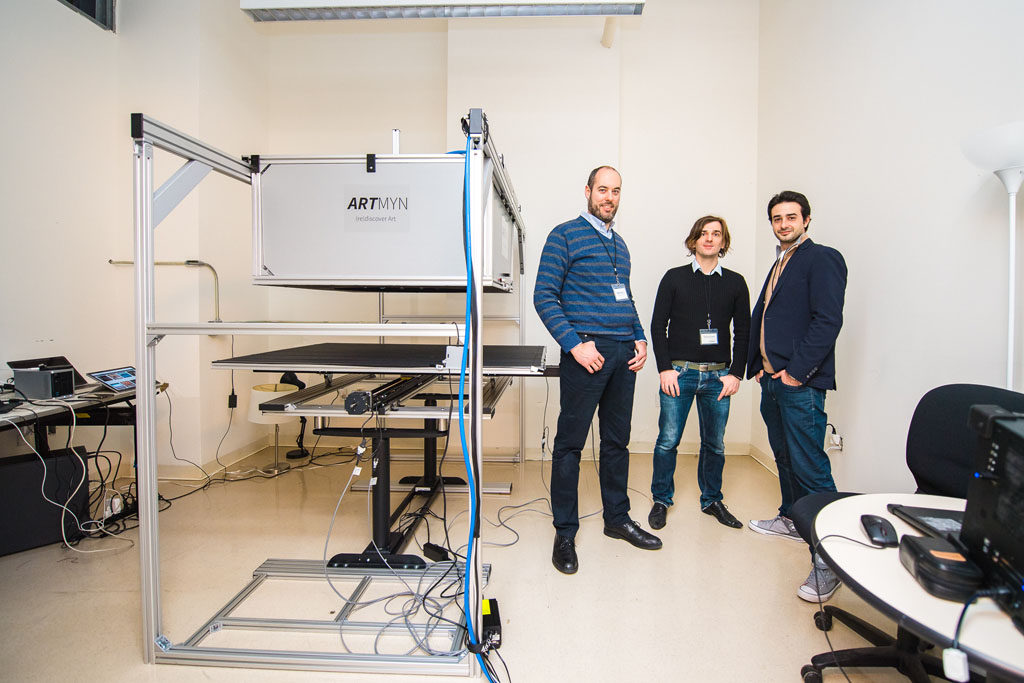After a visit at EPFL in Lausanne we discovered the work of ArtMyn, a startup specialising in Virtual Reality applied to Art. We interwied its founder, Loïc Baboulaz, to understand the genesis of ArtMyn and the evolution of the virtual reality market.
IntoTheMinds : where does the original idea for ArtMyn come from ?
Loic Baboulaz : ARTMYN is born from the academic project called eFacsimile that ran from 2012 to 2015 at the Laboratory of Audiovisual Communications of the Swiss Institute of Technology Lausanne (EPFL). It started from a simple observation: viewing a work of Art on a computer screen gives a very poor experience compared to a real-life visualisation. The goal of this project, sponsored by Google, is to improve the visual experience of seeing Art on a digital screen. After three years of R&D, we had developed our first prototype and set of algorithms: a pure computational imaging solution coupled with a web-based viewer allowing 5 dimensions of interactivity at ultra-high resolution. It was then time to reach out to artwork owners (museums, private collectors, auction houses) and show the potential of our solution for their collection. Our earliest partners were the Fondation Martin Bodmer & BodmerLab in Geneva and the Musée de l’Elysée in Lausanne. Their enthusiasm confirmed that we have a unique powerful technology in our hand and the startup ARTMYN was created in 2016.
IntoTheMinds : where do you see the biggest market potential for your product ? Are there any other application besides the Art market ?
Loic Baboulaz : We are focusing at present on the Art market. If you think about it, most cultural media did their digital transition in the last 10 years giving birth to some large companies: Amazon for books, Netflix for movies, Spotify for music and so on. The art scene however still relies for the very large majority on simple JPEG images, a standard created nearly 25 years ago, to display artworks worth several millions of dollars. Offering a disrupting technology is always complicated. We meet people that really enthusiastic about what we do and wants to go forward together and we also meet people who do not accept change easily. The digital transition is however inevitable for all actors of the Art market: auction houses face a global market with ever-more online buyers; museums must integrate well-thought new technology to attract more visitors, especially the younger crowd; private collectors are encouraged to make their collection publicly visible to increase its value over time. Finally, art insurances are also very interested in our technology as it can provide an objective analysis to help the reporting of the condition of an artwork.
IntoTheMinds : what were the biggest challenges you had to solve ?
Loic Baboulaz : Our computation imaging technology is purely data-driven (CG-free!) and this data is big data. We can easily acquire close to a terabyte of data for a single painting. This raw data needs then to be processing by our algorithms to extract all the relevant information. So speed of acquisition and speed of processing is key. In the last year, we have increase the overall speed by tenfold.
Another big initial challenge was to get approval from art experts, curators and artists. We are fortunate to work now with prestigious institutions such as Sotheby’s or AXA Art insurance. As another example, we digitised in 2016 for the ArtLab exhibition at EPFL an Outrenoir painting by French artist Pierre Soulages. Outrenoirs are basically black painting that are very complex in their texture and in the way it reflects light. Last week, we were honoured to present our work to Pierre Soulages himself who praised the result for “revealing the sophistication and elegance of his paintings”. What a satisfaction to hear this from such a renowned and respected artist!
IntoTheMinds : In our opinion, many of the VR application today offer little value to the user. They are purely entertaining but fail to add real added value and foster repeated use. What are your thoughts on the emerging VR market ? How can value be created for end-users that will foster durable use of VR technology ?
Loïc Baboulaz : I believe that VR is here to stay but I agree with your point of view regarding VR. Besides current price and technology issues, VR needs to go beyond plain entertainment and virtual worlds to get the support of a wider audience than tech consumers . It needs also to include a social component so that VR can be seen as a tool to share an experience. VR applications should also provide data that are enjoyable by people from diverse background and interests, not only the tech consumers. With ARTMYN for example, being able to freely manipulate a multi-million dollars painting from anywhere, at anytime as if you had it in your hand allows people with various expectations (e.g. art amateurs, experts or potential buyers) to equally appreciate the same dataset.
Credits : Julian Cassady Photography
Posted in Innovation, Marketing.

